精通英语六年级上册教案
六年级上册英语教案-Unit 4 第21课∣人教精通
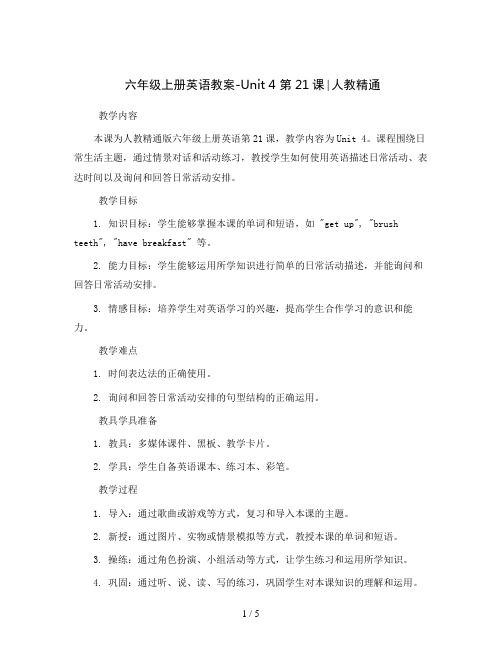
六年级上册英语教案-Unit 4 第21课∣人教精通教学内容本课为人教精通版六年级上册英语第21课,教学内容为Unit 4。
课程围绕日常生活主题,通过情景对话和活动练习,教授学生如何使用英语描述日常活动、表达时间以及询问和回答日常活动安排。
教学目标1. 知识目标:学生能够掌握本课的单词和短语,如 "get up", "brush teeth", "have breakfast" 等。
2. 能力目标:学生能够运用所学知识进行简单的日常活动描述,并能询问和回答日常活动安排。
3. 情感目标:培养学生对英语学习的兴趣,提高学生合作学习的意识和能力。
教学难点1. 时间表达法的正确使用。
2. 询问和回答日常活动安排的句型结构的正确运用。
教具学具准备1. 教具:多媒体课件、黑板、教学卡片。
2. 学具:学生自备英语课本、练习本、彩笔。
教学过程1. 导入:通过歌曲或游戏等方式,复习和导入本课的主题。
2. 新授:通过图片、实物或情景模拟等方式,教授本课的单词和短语。
3. 操练:通过角色扮演、小组活动等方式,让学生练习和运用所学知识。
4. 巩固:通过听、说、读、写的练习,巩固学生对本课知识的理解和运用。
5. 总结:对本课所学知识进行总结,并布置作业。
板书设计板书设计应简洁明了,突出本课的重点和难点。
可以使用图表、颜色或简笔画等方式,帮助学生更好地理解和记忆所学知识。
作业设计1. 书面作业:完成练习册的相关练习,巩固本课所学知识。
2. 口头作业:与家长或同学进行日常活动安排的英语对话练习。
课后反思通过课后反思,教师可以总结本课的教学效果,发现问题,并为下一课的教学做好准备。
教师可以从教学内容、教学方法、学生反馈等方面进行反思。
---本教案遵循了教学内容的逻辑顺序,突出了教学目标,注重了教学难点的处理,充分考虑了教具学具的使用,设计了合理的教学过程,板书设计和作业设计也符合教学要求。
人教精通版小学六年级上册英语教案(全册-共80页)

最新人教精通版小学六年级上册英语教案(全册-共80页)-CAL-FENGHAI-(2020YEAR-YICAI)_JINGBIAN人教精通版小学六年级上册英语教案课题:Unit1 I go to school at 8:00.课题:Unit1 I go to school at 8:00.Lesson 2课题:Unit1 I go to school at 8:00.课题:Unit1 I go to school at 8:00.课题:Unit1 I go to school at 8:00.课题:Unit1 I go to school at 8:00.课题:Unit 2 What’s your hobby?Lesson 7课题:Unit 2 What’s your hobby?课题:Unit 2 What’s your hobby?课题:Unit 2 What’s your hobby?课题:Unit 2 What’s your hobby?课题:Unit 2 What’s your hobby?Lesson 12课题:Unit3 Would you like to come to my birthday party?课题:Unit3 Would you like to come to my birthday party?课题:Unit3 Would you like to come to my birthday party?一边展示十二个生肖图片及单词,一边做Let's do: Act like a..... (引入12生肖,指导学生了解其中几个12生肖的生词)2. Presentation (15′)1)指导学生制作生日邀请卡。
2)学习短语invite your friends to your party, celebrate your birthday with your friends, give a birthday card to your friend.3)运用邀请卡练习会话:Would you like to come to my birthday partySure. I’d love to. Here’s a card for you! Thank you! Goodbye!/ Bye-bye!/ Bye!4)Listen and repeat.T: Listen to the tape and then read after it.5)Just write.T wrtie Four Skills’ words and sentences on blackboard, ask Ss to follow.6)Let’s read and chant:播放Let's read and chant部分的录音两遍。
六年级上册英语教案-Unit 4 第20课∣人教精通

六年级上册英语教案-Unit 4 第20课∣人教精通教学内容本课为六年级上册英语Unit 4的第20课,主题围绕“家庭生活”展开。
课程内容主要涵盖家庭成员的介绍、家庭成员间的相互关系以及家庭日常活动等。
通过本课的学习,学生能够掌握与家庭生活相关的词汇和句型,并能运用所学知识进行简单的英语口语交流。
教学目标1. 知识目标:学生能够掌握本课所学的家庭成员词汇,如“father”、“mother”、“brother”、“sister”等,并能运用这些词汇介绍自己的家庭成员。
2. 能力目标:学生能够运用所学句型,如“I have a ...”和“He/Sheis ...”等进行家庭成员的介绍,并能进行简单的英语口语交流。
3. 情感目标:通过本课的学习,学生能够增强对家庭的热爱和尊重,培养良好的家庭观念。
教学难点1. 家庭成员词汇的掌握:本课涉及多个家庭成员的词汇,学生需要通过反复练习和记忆,熟练掌握这些词汇。
2. 句型的运用:学生需要学会运用所学句型进行家庭成员的介绍,并能进行简单的英语口语交流。
3. 家庭观念的培养:通过本课的学习,学生能够增强对家庭的热爱和尊重,培养良好的家庭观念。
教具学具准备1. 教具:PPT课件、教学录音机、教学视频等。
2. 学具:英语课本、练习册、文具等。
教学过程1. 导入:通过播放与本课主题相关的英语歌曲或视频,激发学生的学习兴趣,引入本课的主题。
2. 新课导入:教师通过PPT课件,展示家庭成员的图片,引导学生学习本课的词汇和句型。
3. 练习:学生通过听录音、跟读、模仿等方式,进行家庭成员词汇和句型的学习和练习。
4. 小组活动:学生分组进行家庭成员的介绍,运用所学知识进行英语口语交流。
5. 课堂小结:教师对本课的学习内容进行总结,巩固学生的学习成果。
6. 作业布置:教师布置与本课内容相关的作业,巩固学生的学习成果。
板书设计板书设计应简洁明了,突出本课的重点内容。
主要包括以下部分:1. 课程六年级上册英语Unit 4 第20课2. 教学目标:知识目标、能力目标、情感目标3. 教学难点:家庭成员词汇的掌握、句型的运用、家庭观念的培养4. 教学内容:家庭成员的介绍、家庭成员间的相互关系、家庭日常活动等5. 教学过程:导入、新课导入、练习、小组活动、课堂小结、作业布置作业设计1. 听力练习:学生听录音,完成家庭成员的听力练习。
精通版小学英语六年级上册全册教案

1.To learn to say and write the sentences: You should go to bed early. You should help to set the dinner table. You shouldn’t go home too late. You should keep your room clean. You shouldn’t make a mess in your room.
Step 2. Knowledge 1. Substitution T: Peter listens to the teacher carefully in class. He is a good student at school. S1: Peter asks questions actively in class. He is a good student at school. S2: Peter is quiet in the library. He is a good student at school. S3: Peter is ready to help others. He is a good student at school. 2. To learn to say the text. Let the students listen to the tape recording with their books closed. Then listen to the text two times with their books open. Read after the tape recording. Try to say this text fluently. Try to retell the text. Pay attention to these sentences: 3. To learn the new words: whole sometimes late till mess 4.Have students practice words and sentences.
人教精通版英语6上六年级上册英语教案

教学步骤:
1.热身/复习(Warming-up / Revision)
1)播放歌曲Nice to see you again的录音,全班同学随着录音,边唱边做动作相互问候。同时,活跃课堂气氛,使假期后重返课堂的学生尽快回到英语学习的氛围中来。
2)教师出示一些假期旅游时拍摄的照片或录像向大家做简单介绍,回答学生提出的问题,在介绍和回答问题的过程中,可以使用一些学生学过的英语,使学生在较短时间内能在宽松愉悦的气氛中迅速回到英语学习中来。
Lesson 1
教学目标:能够用英语表述在学校、家庭、公共场所应该遵守的一些规则,并能在实际生活中自觉运用。
教学重点:熟读本课中出现的单词和句子。
课前准备:
1.准备本课教学挂图和录音磁带;三年级下册歌曲Nice to see you again的磁带。
2.准备一些小纸片供学生投票选举时用。
3.准备若干张彩色A4复印纸,供学生填写班级规则。
Lesson 2
教学目标:会使用do, don't, should, shouldn't, must, mustn't提醒、劝告别人遵守各种规则。
教学重点:
能够正确地听、说、认读以下单词和短语:question, actively, don't, noise, shouldn't, mess, make a mess, room, keep, clean, set, too, late, respect, and, them, take good care of, young, children, keep off, grass, mustn't, cross, now, spit, ground, litter
最新人教精通版小学英语六年级上册优质教案(全册)
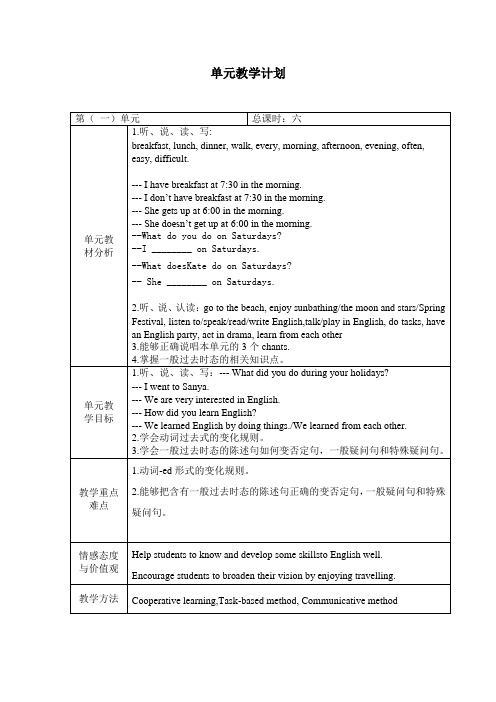
--- We learned English by doing things./We learned from each other.
2.学会动词过去式的变化规则。
3.学会一般过去时态的陈述句如何变否定句,一般疑问句和特殊疑问句。
教学重点难点
课型:Reading
教学准备:Books and pictures, multi-media, blackboard-writing
教学过程与方法
教学环节
教学活动
设计意图
课前德育渗透
Step 1
Step 2
Step 3
Step 4
Step 5
时间观念的涵义是要科学地安排时间,计划用时间,讲究效率,还需要有自控能力。因此,一般家长认为是对成人的要求,而忽视了对孩子的培养。若是父母能在早期养成孩子良好的时间观念,就等于给孩子以知识、力量、聪明和美好的开端。因为善于掌握自己时间的人将会获得高效率工作,也是最能出成绩的人。作为一名学生,要有时间观念,做事不拖拉。
教学重点:Listen to the teacher carefully and recite words correctly.
教学难点:To master the reading skills (fast reading and careful reading).
教学方法:Cooperative learning, Task-based method
单元教学计划
第(一)单元
总课时:六
单元教
材分析
1.听、说、读、写:
breakfast, lunch, dinner, walk, every, morning, afternoon, evening, often,
六年级上册英语教案-Unit1Igotoschoolat8.00lesson1-人教(精通)
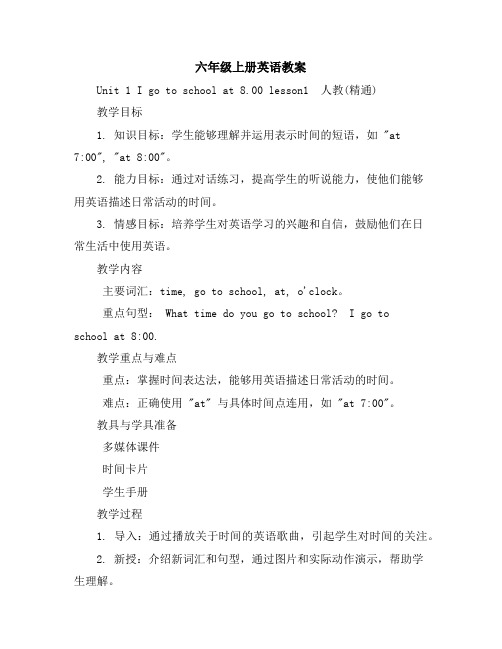
六年级上册英语教案Unit 1 I go to school at 8.00 lesson1 人教(精通)教学目标1. 知识目标:学生能够理解并运用表示时间的短语,如 "at7:00", "at 8:00"。
2. 能力目标:通过对话练习,提高学生的听说能力,使他们能够用英语描述日常活动的时间。
3. 情感目标:培养学生对英语学习的兴趣和自信,鼓励他们在日常生活中使用英语。
教学内容主要词汇:time, go to school, at, o'clock。
重点句型: What time do you go to school? I go toschool at 8:00.教学重点与难点重点:掌握时间表达法,能够用英语描述日常活动的时间。
难点:正确使用 "at" 与具体时间点连用,如 "at 7:00"。
教具与学具准备多媒体课件时间卡片学生手册教学过程1. 导入:通过播放关于时间的英语歌曲,引起学生对时间的关注。
2. 新授:介绍新词汇和句型,通过图片和实际动作演示,帮助学生理解。
3. 练习:进行角色扮演,让学生练习对话,加强记忆。
4. 巩固:通过小组活动,让学生用英语描述自己的日常活动时间。
板书设计中心:时间表达法左侧:重点词汇右侧:重点句型下部:课堂练习示例作业设计书面作业:完成教材中的练习题。
口头作业:与家长进行对话练习,描述自己的日常活动时间。
课后反思反思教学效果,特别是学生对时间表达法的掌握程度。
调整教学方法,以更好地适应学生的学习需求。
为下一节课做好准备,确保教学内容的连贯性。
此教案设计旨在通过多元化的教学方法,帮助学生有效掌握英语时间表达法,并能够在实际对话中灵活运用。
通过歌曲、图片、角色扮演等多种教学手段,激发学生的学习兴趣,提高他们的英语听说能力。
同时,通过课后反思,教师能够不断优化教学策略,以更好地满足学生的学习需求。
最新人教精通版小学英语六年级上册优质教案(全册)
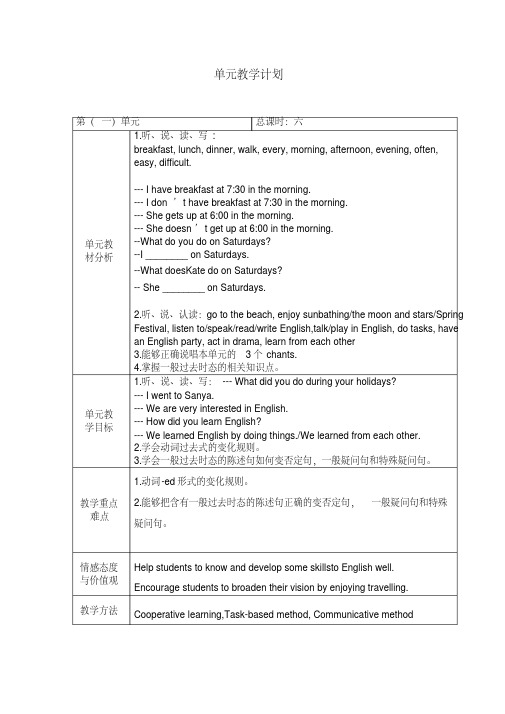
第( 一)单元
总课时:六
1.听、说、读、写 :
breakfast, lunch, dinner, walk, every, morning, afternoon, evening, often,
easy, difficult.
单元教 材分析
--- I have breakfast at 7:30 in the morning. --- I don ’ t have breakfast at 7:30 in the morning. --- She gets up at 6:00 in the morning. --- She doesn ’ t get up at 6:00 in the morning. --What do you do on Saturdays? --I ________ on Saturdays.
To improve students reading
Step 4
Answer 3: She goes to bed about 9:30
ability.
To
let
Careful reading
students
Q4:Introduce the Lucy ’s school life. (according
Introduce the Lucy
’s school life. (according time)
Answer: get up----have breakfast-----go to school
---- school begins----have lessons
----have lunch at school----- school is over---- go
六年级英语精通版上册教案
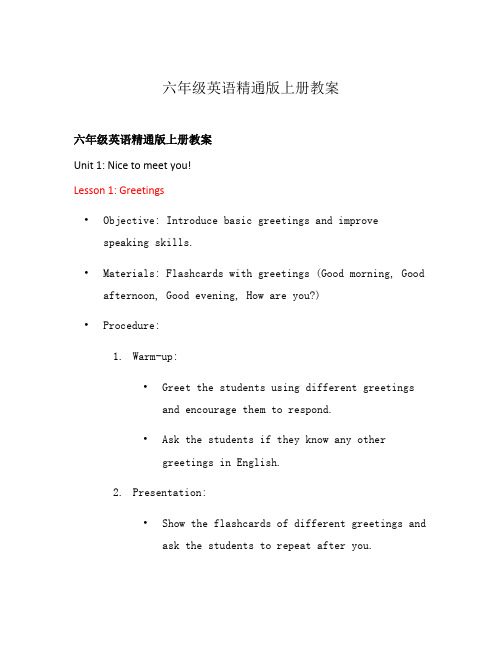
六年级英语精通版上册教案六年级英语精通版上册教案Unit 1: Nice to meet you!Lesson 1: Greetings•Objective: Introduce basic greetings and improve speaking skills.•Materials: Flashcards with greetings (Good morning, Good afternoon, Good evening, How are you?)•Procedure:1.Warm-up:•Greet the students using different greetingsand encourage them to respond.•Ask the students if they know any othergreetings in English.2.Presentation:•Show the flashcards of different greetings and ask the students to repeat after you.•Practice pronunciation and emphasize thecorrect intonation.3.Practice:•Divide the students into pairs and ask them to practice greeting each other using theflashcards.•Monitor their pronunciation and providefeedback.4.Extension activity:•Have a role-play activity where students will pretend to meet someone for the first time andgreet each other using the greetings learned.•Encourage creativity and provide positive feedback.5.Summary:•Review the greetings and ask the students to summarize what they have learned.6.Homework:•Assign vocabulary exercises related togreetings for homework.Lesson 2: Introducing myself•Objective: Learn how to introduce oneself using basic personal information.•Materials: Flashcards with personal information (Name, Age, Nationality, School, Grade)•Procedure:1.Warm-up:•Review the greetings learned in the previouslesson.•Ask the students to introduce themselves using their names and greet the class.2.Presentation:•Show the flashcards of personal informationand pronounce each word clearly.•Ask the students to repeat after you andpractice pronunciation.3.Practice:•Divide the students into pairs and ask them to take turns introducing themselves using theflashcards.•Monitor their pronunciation and providefeedback.4.Extension activity:•Conduct a mini interview activity wherestudents will ask each other questions aboutpersonal information and introduce theirpartners to the class.•Encourage active listening and providepositive feedback.5.Summary:•Review the personal information learned and ask the students to summarize what they havelearned.6.Homework:•Assign writing exercises where students will write short paragraphs introducing themselvesusing the personal information learned.Unit 2: My FamilyLesson 1: Family Members•Objective: Learn vocabulary related to family members and improve speaking skills.•Materials: Flashcards with family member names (Father, Mother, Brother, Sister, Grandfather, Grandmother) •Procedure:1.Warm-up:•Ask the students about their family membersand encourage them to share some information.•Introduce the English names of family membersand ask if they know these words.2.Presentation:•Show the flashcards of family members andpronounce each word clearly.•Ask the students to repeat after you andpractice pronunciation.3.Practice:•Divide the students into pairs and ask them to describe their family members using theflashcards.•Monitor their pronunciation and providefeedback.4.Extension activity:•Have a group discussion where students willtalk about their family members and shareinteresting facts.•Encourage active participation and providepositive feedback.5.Summary:•Review the family member names and ask thestudents to summarize what they have learned.6.Homework:•Assign vocabulary exercises related to familymembers for homework.Lesson 2: Family Tree•Objective: Learn how to describe family relationships and improve speaking and listening skills.•Materials: Family tree diagram, flashcards with family member names•Procedure:1.Warm-up:•Review the family member names learned in the previous lesson.•Ask the students if they know how to describe the relationship between different familymembers.2.Presentation:•Show the family tree diagram and explain howto describe family relationships using termslike “father,” “mother,” “brother,”“sister,” “grandfather,” “grandmother,”“uncle,” “aunt,” etc.•Use the flashcards to demonstrate examples and practice pronunciation.3.Practice:•Divide the students into pairs and ask them to take turns describing their familyrelationships using the family tree diagramand flashcards.•Monitor their pronunciation and providefeedback.4.Extension activity:•Conduct a group activity where students will create their own family tree diagrams anddescribe their family relationships to theclass.•Encourage creativity and provide positive feedback.5.Summary:•Review the family relationships learned and ask the students to summarize what they havelearned.6.Homework:•Assign writing exercises where students will write short paragraphs describing their familyrelationships using the vocabulary learned.Lesson 3: Family Activities•Objective: Learn vocabulary related to family activities and improve speaking skills.•Materials: Flashcards with family activity names (Eat together, Play games, Watch movies, Go on a picnic) •Procedure:1.Warm-up:•Ask the students about the activities they dowith their families.•Introduce the English names of familyactivities and ask if they know these words.2.Presentation:•Show the flashcards of family activities andpronounce each word clearly.•Ask the students to repeat after you andpractice pronunciation.3.Practice:•Divide the students into pairs and ask them to discuss and share their favorite familyactivities using the flashcards.•Monitor their pronunciation and providefeedback.4.Extension activity:•Have a class discussion where students will talk about their favorite family activitiesand why they enjoy them.•Encourage active participation and provide positive feedback.5.Summary:•Review the family activity names and ask the students to summarize what they have learned.6.Homework:•Assign vocabulary exercises related to family activities for homework.。
六年级上册英语教案-Unit3Lesson16∣人教精通

六年级上册英语教案-Unit3 Lesson16∣人教精通教学内容本课为六年级上册英语“人教精通”版Unit 3的Lesson 16,教学内容主要围绕一般过去时态。
课程内容包括词汇学习、句型练习、听力理解和角色扮演等环节。
学生将通过学习,掌握描述过去发生事件的基本结构,并能运用相关词汇和句型进行简单的英语交流。
教学目标1. 知识目标:学生能够听懂、会说、会读本课的生词和重点句子,并能运用一般过去时态描述过去的经历。
2. 能力目标:培养学生运用英语进行交际的能力,提高学生的听说技能和合作学习能力。
3. 情感目标:激发学生学习英语的兴趣,增强学生自信心,培养学生积极向上的情感态度。
教学难点1. 正确运用一般过去时态描述过去的经历。
2. 掌握本课的生词和短语,并能将其运用到实际情境中。
3. 听懂并准确回应英语指令和问题。
教具学具准备1. 多媒体教学设备2. PPT课件3. 教学录音机4. 黑板和粉笔5. 学生用书和练习册教学过程1. 导入:利用图片或故事引入本课主题,激发学生兴趣。
2. 新课内容呈现:通过PPT课件展示本课的生词和重点句子,引导学生跟读并模仿。
3. 操练:设计相关活动,如角色扮演、小组讨论等,让学生在实际语境中运用所学知识。
4. 听力练习:播放教学录音,让学生听懂并回应相关指令和问题。
5. 课堂小结:总结本课所学内容,强调重点和难点。
6. 作业布置:布置课后作业,巩固所学知识。
板书设计板书设计要简洁明了,突出本课的重点和难点。
可以采用以下布局:- 课题:Unit 3 Lesson 16- 重点词汇:展示本课的生词和短语- 重点句子:展示本课的重点句子和句型- 结构框架:展示一般过去时态的基本结构作业设计1. 完成练习册上的相关练习。
2. 背诵本课的生词和重点句子。
3. 写一篇小短文,描述自己过去的一次经历。
课后反思1. 教学内容是否充实,是否符合学生的实际需求。
2. 教学方法是否得当,是否能够激发学生的学习兴趣。
精通英语六年级上册教案

Unit 1 I go to school at 8:00 .Lesson 1I Teaching Aims1 Knowledge aim(1) Understand and speak out the words : go to school , morning , at , AM .(2) Understand and speak out the sentences : I get up at 7:30 in the morning .(3) Study e-mail’s format .(4) Can write the words and sentences .2 Ability aim(1) Can make sentences with the words .(2) Can apply the sentences to the real situation .3 Teaching affection(1) To promote the Ss’ cooperation .(2) To foster the Ss’ interest .(3) To foster the Ss’ confidence .(4) To foster the Ss’ good habit(5) To know the west ’ cultures .II Teaching important and difficult point .1Apply the sentences to the real situation .2Pay attention the Ss’ pronunciation and tones .III Teaching AidsCountry flags , recorder , picture card , stickers .IV Teaching Methods1Direct teaching method2Situational teaching method3Listening and speaking4TPR happy teaching methodV Teaching proceduresStep 1 Warming-up \ Revision (3’)(1)Sing a song : I want to be your friend .(2)GreetingStep 2 Presentation (17’)(1)T : Guess, where does they come from ?( Show the pictur.)(2)Listen and answer some questions : Where does Lucy come from ? What’sthe e-mail about ?(3)Talk about your daily life .(4)Read the e-mail .Step 3 Practice (10’)Talk about your daily life to partners .Step 4 Assessment (10’)Read the words and sentences to your group leader .VI HomeworkWrite the words and sentences .VII The Blackboard designLesson 1Lucy’ daily life :Get up : Go to school:Have classes : Go home :Watch TV : Go to bed :VIII Back courtingLesson 2I Teaching Aims1 Knowledge aim(1) Understand and speak out the words : have breakfast ,have lunch , have dunner ,go to school , have classes , go home , watch TV , go to bed , 7:00 AM , 12:00 , 6 :00 PM .(2) Understand and speak out the sentences : I go to school at 7 :00 in the morning . I go to bed at 9 :oo in the evening .(3) Can dictation the words and the sentences .(4) Let’s make motes .(5) Let’s read and chant .2 Ability aim(1) Can introduce my daily life to others .(2) Can make notes .(3) Develop the Ss’ imagination .3 Teaching Affection(1) Have a nice habit .(2) To promote the Ss’ cooperation .(3) To foster the Ss’ confidence .II Teaching important and difficult point(1)Apply the sentences to the real situation .(2)Attention the Ss’ pronunciation and tones .(3)Can dictation the main words and sentence .III Teaching Aidspicture card , recorder , stickers , clock .IV Teaching Methods1 Direct Teaching Method2 Listening and SpeakingV Teaching ProceduresStep 1 Warming-up \ Revision (5’)Sing a song : I have --- in the ---Read the wordsStep 2 Practice (15’)(1)T: We usually go to school .What time do you usually go to school ?(Show the clock . )(2)Introduce your daily life .(3)Listen to the tape and repeat .Step 3 Practice (15’)Make the sentences with words .Make your daily life note in your group .Let’ read and chant .Step 4 Consolidation (5’)Write the main words and sentence .VI The homeworkDictation the master words and sentence to your group leader .VII The black board designLesson 2I have breakfast at__________________I have lunch at _____________________I have dinner at __________________________I go to school at 7:00 in the morningVIII Back CourtingLesson3I Teaching Aims1 Knowledge aim(1) Understand and speak out the words : get up , get home , take a long walk ,water the flowers ,play with his pet dog ,best wishes .(2) Understand and speak out the text .2 Ability aim(1) Make the sentence with the words .(2) Can introduce about others’ daily life .(3) Affection aim(1) To promote the Ss’ conffidence and interest .(2) To teach the Ss have a good habit in daily life .II Teaching Important and Difficult point .(1)Can understand and speak out the text .(2)Can speak in right tones .III Teaching Aidsrecorder –tape , picture card , stickers .IV Teaching Methods1 Direct Teaching Method2 Listening and SpeakingV Teaching ProceduresStep 1 Warming-up \ Revision (5’)Duty—report :Let me tell you something about my family .Step 2 Presentation (15’)(1)T: You have a happy family . And whom do you love best I your family ?Why ?(2)Listen to the tape . Try to answer the questions : What is Lucy talking ?How does Lucy’ grandpa daily life ?(3)Read text together .(4)Teach the words .Step 3 Practice (10’)(1)Read the text one by one in you group .Step 4 Assessment (10’)(1)Have a race :Ask and answer some questions .VI HomeworkAnswer the questions :What tune does her grandpa get up ?What does he do from 6:15 to 7:00 ?What does he usually do in the afternoon ?Does he go out in the evening ?What time does he go to bes ?VII The blackboard DesignLesson 3My grandpa’ daily lifeHe gets up at 6:00 every morning .He take a long walk from 6:15 to 7:00 in the morning .He reads the newspapers in the morning .He usually waters the flowers in his garden or plays with his pet dog in theafternoon .He don't go out in the evening .He goes to bed at about 9:30 in the evening .VII IBack CourtingLesson 4I Teaching Aims1 Knowledge aim(1) Understand and speak out the words :cook breakfast , teach English, read stories, take a walk ,in the evening , doesn’t , don’t(2) understand and speak out the sentences : I get up at 7:00 in the morning . He gets up at 6:00 in the morning .(3) Talk about others daily life .(4) Let’s read and chant .2 Ability aim(1) Can make sentences with the words .(2) Can introduce others daily lefe .3 Affection aim(1) To promote the Ss’ interest and cofidence .(2) To foster the Ss’ cooperation .(3) To foster the Ss’ good habit .II Teaching Important and Difficult point(1)Apply the sentences to the real situation .(2)Pay attention the Ss’ pronunciation and tones .(3)Can introduce others daily life .III Teaching Aidspicture card , recorder-tape , some photos , stickers .IV Teaching Methods1Direct TeachingMethod2Listening and Speaking3TPR happy Teaching MethodV Teaching ProceduresStep 1 Warming-up \ Revision (5’)(1)Listen and do .(2)Read the cards .Step 2 Presentation (15’)(1) Duty –report :Talk about my daily life .(2) Make sentences with the words .(3) Listen to the tape and repeat .(4) T :Look at the picture . This is my mother . She usually goes to work by bike .And look at my father . He usually goes to the cinema .How about your mother or your father ? How about your friend ?Step 3 Practice (15’)(1)Bring a few photos of your family or friends and talk about them in group .(2)Let's read and chant .Step 4 Assessmemt (5’)Dictation the main words and sentences in you groupleader.VI HomeworkRead the words and sentences .VII The blackboard DesignLesson 4I get up at 7:00 in the morning .She gets up at 6:00 in the morning .Lesson 5I Teaching Aims1 Knowledge aim(1) Understand and speak out the wouds : see a film, practise, usually , office , afternoon , in the afternoon ( PM ) .(2) Understand and speak out the text .2 Ability aim(1) Can act the dialogue .(2) Can make the sentences with the words .3 Affection aim(1) To teach the Ss get information from others .(2) To promote the Ss’ interest and confidence .II Teaching Important and Difficult point(1)Can ask others and get some informations .(2)Can understand and act out the dialogue .(3)Pay attention the Ss’ pronunciation and tones .III Teaching Aidssome scientist photos , picture card , recorder-tape , stickers .IV Teaching Methods1 Direct Teaching Method2 Listening and SpeakingV Teaching ProceduresStep 1 Warming-up \ Revision (5’)Ask and answer about others daily life .Step 2 Presentation (15’)(1)Teach the words :scientist , office , work , usually .T :Who is in the picture ? (Show the scientist photos.)This is famous scientist Mr ---. Can you tell me some things about his daily life ? How does he usually wouk ?(2)Listen to tape and try to answer some questions .(3)Can you speak out the scintist’ daily life ? Do you like him ? Why ?(4)Read The dialogu .Step 3 Practice (15’)Reaed dialogu in your group and act it .Step 4 Assessment (5’)Make sentences with the words : always , usually , often , sometimes .seldom ,never .VI HomeworkRead the text to your groupler .VII The blackboard DesignLesson 5What do you do on Saturdays?I usually have piano classes.Lesson 6I Teaching Aims1 Knowledge aim(1) Can understand the words and sentences .(2) Can speak out in right tone .(3) Apply the sentences and words in the real situation .(4) Let’s read and chant .2 Ability aim(1) Can make the sentence with the words .(2) Can go on a field trip\ interview .3 Affection aim(1)To promote the Ss’ cooperation .(2) To foster the Ss’ confidence and interest .II Teaching Aidspicture card , recorder-tape , stickers .III Teaching Important and Difficult point(1)Apply the sentences to the real situation .(2)Pay attention the Ss’ pronunciation and tones .(3)Write and dictate the sentences and wordsIV Teaching Methods1Situational Teaching Method2Listening and SpeakingV Teaching ProceduresStep 1 Warming-up \ Revision (5’)Duty-report : The person I like best .Read the words .Step 2 Presentation (10’)(1)Have a race : What does Mr Li always \ usually \ often \ sometimes \ seldom\ never do ? (Show the picture .)(2)Listen to the tape and repeat .Step 3 Practice (20’)(1)Let’s go on a field trip .(2)Group work .(3)Let’ read and chant .Step 4 Assessment (5’)Write the words and sentences .VI HomeworkDictation the words and sentences .VII The blackboard DesignLesson 6What do you do on Saturdays?I often ___________________________________________________What does he/she do on Saturdays?He \ She ___________________________________________________ VIII Back CourtingRevisionDate :Time arrange :The seventh periodLesson Type : Consolidation lessonI Teaching Aims1 Knowledge aim(1) Consolidate the main words and sentences in the Unit1.(1) Can speak out in right tone .2 Ability aim(1) Can apply the words and sentences to the real situation .(2) Can act the story .3 Affection aim(1) To promote the Ss’ confidence and interest .(2) To foster the Ss’ cooperation .(3) To teach the Ss to hard work .II Teaching Important and Difficult point(1)Apply the sentences and words in the Unit 2 to the real situation .(2)Pay attention the Ss’ pronunciation and tones .(3)Can advise good suggestion to others .III Teaching AidsHeadprops , picture card , recorder-tape , stickers .IV Teaching Methods1Situational Teaching Method2Listening and Speaking3Group workV Teaching ProceduresStep 1 Warming-up \ Revision (5’)Sing a song : Sing , sing together .T: You can sing sweetly . I can not sing sweetly. But I want to sing sweetly . Why are you singing so sweetly ? Can you help me ?Step 2 Presentation (15’)(1)Observe the pictures in the story . Talk about the picture .(2)Listen to tape and answer some questions : Do Micky and Mimi get up veryearly ? Who do they see ? What is the bird doing ? What does micky want to do ? How does he learn to sing ? Can he sing sweetly now ?What’s the bird’s idea ? Can you guess ?(3)Talk about suggestion in your group .Step 3 Practice (15’)Act the story .Step 4 Assessment (5’)Write the good suggestion .VI HomeworkRead the story to you groupleader .VII The Blackboard DesignUnit 1 RevisionWho is a good dancer ?Because :________________________________________________VIII Back CourtingUnit 2:What’s your hobby?言语技能目标1、能够用英语向别人简单介绍自己的兴趣和爱好。
人教精通版六年级上册英语教案

人教精通版六年级上册英语教案第一课时:Unit 1 Hello!教学目标:1. 学生能够听、说、认读并能书写26个英文字母。
2. 学生能够用英语进行个人的自我介绍。
3. 学生能够灵活运用问候语相互交流。
教学重点:1. 学生能够正确地听、说、认读26个英文字母。
2. 学生能够用英语进行自我介绍。
教法:任务型教学法,情景教学法教学准备:PPT课件,挂图,音频设备,黑板教学过程:Step 1: Greeting (5 minutes)- T: Good morning, students!- Ss: Good morning, teacher!- T: How are you today?- Ss: I'm fine, thank you. And you?- T: I'm fine too. Thank you.Step 2: Presentation (15 minutes)- T: Now, let's learn the English alphabet. First, I'll show you the uppercase letters. (Teacher shows the PPT with the uppercase letters.)- T: Repeat after me and pay attention to the pronunciation. Let's go!- Ss: (Repeat after the teacher)- T: Great! Now, let's learn the lowercase letters. (Teacher shows the PPT with the lowercase letters.)- T: Repeat after me, and remember the shape of each letter. Let's go!- Ss: (Repeat after the teacher)Step 3: Practice (20 minutes)- T: Now, let's practice the letters together. I'll show you a letter, and you tell me its name and the sound it represents.- T: (Teacher shows a flashcard with a letter)- S1: It's "A". The sound is /æ/.- T: Excellent! Now, let's continue.- T: (Teacher shows another flashcard with a letter)- S2: It's "B". The sound is /b/.- T: Well done! Keep it up!- T: (Teacher continues showing flashcards and students provide answers accordingly.)Step 4: Introduction (10 minutes)- T: OK, now I want each of you to say your name and an English letter that starts with the same sound as your name.- T: For example, my name is Miss Smith, and I'll say "My name starts with 'S', just like 'Smith'."- S1: (Student says their name and an English letter)- T: Well done! Let's continue.Step 5: Role Play (15 minutes)- T: Now, let's practice some basic greetings and introductions. I'll give you different scenarios, and I want you to act them out in pairs.- T: Scenario 1: You meet a new classmate. Introduce yourselves and say hello.- T: Scenario 2: You meet your teacher in the morning. Greet your teacher and ask how he/she is doing.- T: Scenario 3: Your friend has just come back from a trip. Greet your friend and ask if he/she had a good time.- T: (Students work in pairs and perform the role play.)Step 6: Wrap-up and Homework (5 minutes)- T: Great job today, everyone! Remember to practice saying the letters and greetings every day. For homework, I want you to write a short paragraph introducing yourself in English. You can use the sample we practiced today as a reference.- T: That's all for today. See you next time!- Ss: Goodbye, Miss Smith!教学反思:本节课通过任务型教学法和情景教学法相结合,让学生在实际交流中学习英文字母的名称和发音,并能够进行简单的自我介绍和问候。
精通英语六年级上册教学计划
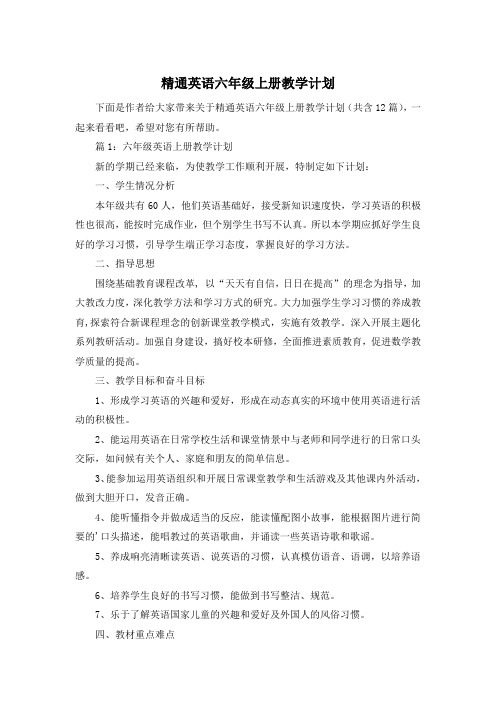
精通英语六年级上册教学计划下面是作者给大家带来关于精通英语六年级上册教学计划(共含12篇),一起来看看吧,希望对您有所帮助。
篇1:六年级英语上册教学计划新的学期已经来临,为使教学工作顺利开展,特制定如下计划:一、学生情况分析本年级共有60人,他们英语基础好,接受新知识速度快,学习英语的积极性也很高,能按时完成作业,但个别学生书写不认真。
所以本学期应抓好学生良好的学习习惯,引导学生端正学习态度,掌握良好的学习方法。
二、指导思想围绕基础教育课程改革, 以“天天有自信,日日在提高”的理念为指导,加大教改力度,深化教学方法和学习方式的研究。
大力加强学生学习习惯的养成教育,探索符合新课程理念的创新课堂教学模式,实施有效教学。
深入开展主题化系列教研活动。
加强自身建设,搞好校本研修,全面推进素质教育,促进数学教学质量的提高。
三、教学目标和奋斗目标1、形成学习英语的兴趣和爱好,形成在动态真实的环境中使用英语进行活动的积极性。
2、能运用英语在日常学校生活和课堂情景中与老师和同学进行的日常口头交际,如问候有关个人、家庭和朋友的简单信息。
3、能参加运用英语组织和开展日常课堂教学和生活游戏及其他课内外活动,做到大胆开口,发音正确。
4、能听懂指令并做成适当的反应,能读懂配图小故事,能根据图片进行简要的'口头描述,能唱教过的英语歌曲,并诵读一些英语诗歌和歌谣。
5、养成响亮清晰读英语、说英语的习惯,认真模仿语音、语调,以培养语感。
6、培养学生良好的书写习惯,能做到书写整洁、规范。
7、乐于了解英语国家儿童的兴趣和爱好及外国人的风俗习惯。
四、教材重点难点1、能按四会、三会的要求掌握所学单词。
2、能按四会要求掌握所学句型。
3、能使用日常交际用语,活用四会句型,进行简单的交流,做到大胆开口,发音正确。
4、能在图片、手势、情境等非语言提示的帮助下,听懂清晰的话语和录音。
5、养成良好的书写习惯,能做到书写整洁、规范。
五、主要教学措施1、以活动为课堂教学的主要形式,设计丰富多彩的教学活动,让学生在乐中学、学中用,从而保证学生英语学习的可持续性发展。
六年级上册英语教案-Unit 4 第19课∣人教精通

六年级上册英语教案-Unit 4 第19课∣人教精通教学内容本课为六年级上册英语Unit 4的第19课,主题围绕“家庭生活”展开。
课程内容主要涵盖家庭成员的介绍、家庭成员间的相互关系以及家庭日常活动等。
通过本课的学习,学生能够掌握与家庭生活相关的词汇和句型,并能运用所学知识进行简单的英语口语交流。
教学目标1. 知识目标:学生能够掌握家庭成员的英语表达,如“father”、“mother”、“brother”、“sister”等,并能正确运用这些词汇进行家庭成员介绍。
2. 能力目标:学生能够运用所学句型描述家庭成员间的关系和特点,如“He is my father. He is a doctor.”等。
3. 情感目标:培养学生对家庭生活的热爱和责任感,增进家庭成员间的亲情交流。
教学难点1. 家庭成员间的相互关系描述:如何运用所学句型正确表达家庭成员间的关系,如“ She is my mother’s sister. She is my aunt.”等。
2. 家庭日常活动的描述:如何运用所学词汇和句型描述家庭日常活动,如“ We often watch TV together in the evening.”等。
教具学具准备1. 教具:PPT课件、教学视频、黑板、粉笔等。
2. 学具:学生自备英语课本、笔记本、文具等。
教学过程1. 导入:通过播放一首关于家庭的英文歌曲,激发学生的学习兴趣,引导学生进入本课主题。
2. 新课内容展示:利用PPT课件,展示家庭成员的图片和英文表达,引导学生学习并掌握家庭成员的英语词汇。
3. 句型学习:通过教学视频,展示家庭成员间的关系和特点,引导学生学习并掌握描述家庭成员关系的句型。
4. 小组活动:学生分组进行角色扮演,运用所学词汇和句型进行家庭成员介绍和日常活动描述。
5. 课堂小结:对本节课所学内容进行总结,巩固学生对家庭成员词汇和句型的掌握。
6. 作业布置:布置与家庭生活相关的英语作业,如写一篇关于自己家庭成员的英语短文等。
精通英语六年级上册教案(全册)

本学期教学进度一览Unit1 I go to school at 8:00Lesson 1一知识与能力目标1.学习简单介绍自己的日常生活和学习情况。
2.熟悉英文e-mail的格式,并在实际生活中应用。
二教学过程与方法目标能够正确地听、说、认读下面的单词和句子:e-mail、daily life、after dinner 、best wishes、London、 minutes等I get up at 7:30 in the morning.三情感态度与价值观目标在日常生活中主动养成良好的学习、生活和劳动习惯。
四教学重点:I get up at 7:30 in the morning.I go to school at 8:30.难点:e-mail、daily life、after dinner 、best wishes、London、 minutes等三、教学工具:Pictures、tape、recorder.【教学过程】:1.热身 / 复习(Warming-up / Revision)1)师生问好。
T: Good morning .S: Good morning: Nice to see you again!S: Nice to see you again!2)猜谜游戏:教师向学生介绍说自己结识了一个外国新笔友,并请学生根据国旗图片呈现说出是哪个国家的。
教师可参考使用以下语言:I have a new pen pals.She often write e-mail to me and I often write e-mail to her, too.Let's look at the pictures in her e-mails.Can you guess where they come from?2.新课导入(Presentation)1)教师总结游戏结果,可以提问2~3名学生:Where does Luce come from?学生答出:Luce comes from London.2)教师以对话的方式,引导学生说出:An e-mail,然后,教师告诉学生看别人的东西需要事先征得同意。
六年级上册英语教案-Unit3 Lesson15∣人教精通

六年级上册英语教案-Unit3 Lesson15∣人教精通教学内容本课为六年级上册英语“人教精通”版Unit 3的Lesson 15,教学内容主要围绕一般过去时态。
课程内容包括词汇学习、句型练习、听力理解和角色扮演等环节。
学生将通过学习,掌握描述过去发生事件的基本结构,并能够运用所学词汇和句型进行简单的交流。
教学目标1. 知识目标:学生能够听懂、会说、会读本课的生词和短语,如“yesterday”, “went”, “played”等。
2. 能力目标:学生能够运用一般过去时态描述过去发生的事情,并能在实际对话中正确运用。
3. 情感目标:培养学生对英语学习的兴趣,增强他们用英语交流的自信心。
教学难点1. 正确使用一般过去时态,尤其是不规则动词过去式的记忆和应用。
2. 听力练习中细节信息的捕捉和理解。
3. 学生在角色扮演活动中,如何自然流畅地进行对话。
教具学具准备1. 多媒体教学设备:用于播放课件和听力材料。
2. 词卡和句型卡片:用于词汇和句型的展示和练习。
3. 角色扮演道具:根据对话内容准备相关道具,增加活动趣味性。
教学过程1. 导入(5分钟)- 通过问答方式复习上一课的内容,自然过渡到本课主题。
- 利用图片或故事引入一般过去时态的概念。
2. 词汇和句型学习(15分钟)- 使用词卡教授新词汇,并通过例句展示其用法。
- 引导学生通过替换练习熟悉句型。
3. 听力练习(10分钟)- 播放听力材料,学生完成相关练习。
- 听后讨论,检查答案,解析难点。
4. 角色扮演(15分钟)- 学生分组,根据提供情景进行角色扮演。
- 鼓励学生使用本课所学句型和词汇。
5. 总结和作业布置(5分钟)- 简要回顾本课重点内容。
- 布置作业,巩固学习成果。
板书设计板书将清晰地展示本课的关键词汇、句型以及重点语法项目。
通过颜色和图示增加视觉效果,帮助学生更好地理解和记忆。
作业设计1. 完成课本练习册中与本课相关的练习题。
2. 写一篇简短的英文日记,描述昨天的活动,至少使用5个本课新学的词汇。
六年级上册英语教案-Unit 4 第23课∣人教精通
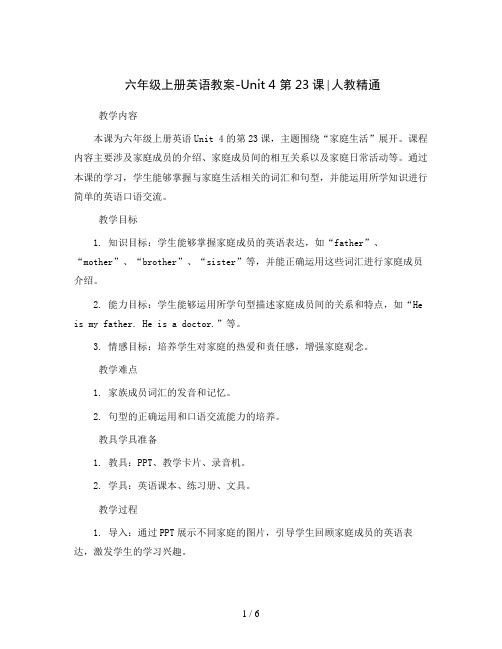
六年级上册英语教案-Unit 4 第23课∣人教精通教学内容本课为六年级上册英语Unit 4的第23课,主题围绕“家庭生活”展开。
课程内容主要涉及家庭成员的介绍、家庭成员间的相互关系以及家庭日常活动等。
通过本课的学习,学生能够掌握与家庭生活相关的词汇和句型,并能运用所学知识进行简单的英语口语交流。
教学目标1. 知识目标:学生能够掌握家庭成员的英语表达,如“father”、“mother”、“brother”、“sister”等,并能正确运用这些词汇进行家庭成员介绍。
2. 能力目标:学生能够运用所学句型描述家庭成员间的关系和特点,如“He is my father. He is a doctor.”等。
3. 情感目标:培养学生对家庭的热爱和责任感,增强家庭观念。
教学难点1. 家族成员词汇的发音和记忆。
2. 句型的正确运用和口语交流能力的培养。
教具学具准备1. 教具:PPT、教学卡片、录音机。
2. 学具:英语课本、练习册、文具。
教学过程1. 导入:通过PPT展示不同家庭的图片,引导学生回顾家庭成员的英语表达,激发学生的学习兴趣。
2. 新课内容呈现:利用教学卡片,逐一呈现家庭成员的词汇和句型,并进行讲解和示范。
3. 操练:学生分组进行角色扮演,运用所学知识进行家庭成员介绍和口语交流。
4. 巩固:通过练习册上的练习,巩固所学知识,提高学生的运用能力。
5. 小结:总结本课所学内容,强调重点和难点。
6. 作业布置:布置与家庭生活相关的作业,如写作、口语练习等。
板书设计1. Unit 4 第23课家庭生活2. 词汇:father、mother、brother、sister等3. 句型:He is my father. He is a doctor.等作业设计1. 完成练习册上的家庭成员介绍题目。
2. 编写一个关于自己家庭的英语小短文。
3. 与家人进行英语口语交流,介绍家庭成员。
课后反思本课通过家庭成员的介绍和口语交流,让学生掌握了与家庭生活相关的词汇和句型。
六年级上册英语教案-Unit4第22课∣人教精通
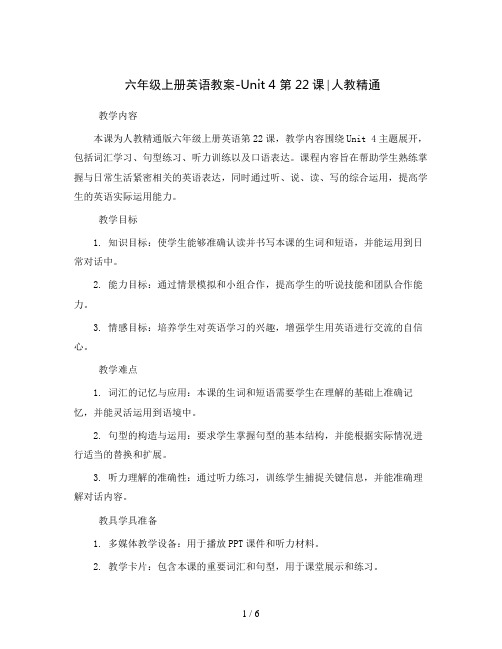
六年级上册英语教案-Unit 4 第22课∣人教精通教学内容本课为人教精通版六年级上册英语第22课,教学内容围绕Unit 4主题展开,包括词汇学习、句型练习、听力训练以及口语表达。
课程内容旨在帮助学生熟练掌握与日常生活紧密相关的英语表达,同时通过听、说、读、写的综合运用,提高学生的英语实际运用能力。
教学目标1. 知识目标:使学生能够准确认读并书写本课的生词和短语,并能运用到日常对话中。
2. 能力目标:通过情景模拟和小组合作,提高学生的听说技能和团队合作能力。
3. 情感目标:培养学生对英语学习的兴趣,增强学生用英语进行交流的自信心。
教学难点1. 词汇的记忆与应用:本课的生词和短语需要学生在理解的基础上准确记忆,并能灵活运用到语境中。
2. 句型的构造与运用:要求学生掌握句型的基本结构,并能根据实际情况进行适当的替换和扩展。
3. 听力理解的准确性:通过听力练习,训练学生捕捉关键信息,并能准确理解对话内容。
教具学具准备1. 多媒体教学设备:用于播放PPT课件和听力材料。
2. 教学卡片:包含本课的重要词汇和句型,用于课堂展示和练习。
3. 小组活动道具:用于情景模拟和角色扮演。
教学过程1. 导入:利用图片或简短视频引起学生对本课主题的兴趣,激活学生的背景知识。
2. 新授:通过PPT展示本课的主要词汇和句型,配合讲解和例句,帮助学生理解和记忆。
3. 实践:设计小组活动,让学生在模拟的情境中使用新学的词汇和句型进行对话练习。
4. 巩固:通过听力练习和书面练习,加深学生对知识的理解和运用。
5. 总结:回顾本课重点,强调关键知识点,布置作业。
板书设计板书将简洁明了地展示本课的主要词汇、句型以及关键语法点,并配合例句和图表,帮助学生更好地理解和记忆课程内容。
作业设计1. 书面作业:要求学生完成课后练习,巩固词汇和句型的书写。
2. 口头作业:学生需在家中与家长或同伴进行对话练习,提高口语表达能力。
3. 拓展作业:鼓励学生利用互联网资源,寻找与本课主题相关的英语材料进行自主学习。
(完整版)人教精通版小学六年级英语上册教案

Unit 2 What`s your hobby?1.能听、说、认读以下词语:collect toy cars, collect stamps, collect maps, collectpicture cards, go fishing, plant flowers, cook meals, play computer games, make dolls, take photos2.能听、说、读、写以下词语:open, hobby, collect, map, box, colour, dad, mum,plant, flower, drink, tea, take, kid, hungry, photo, baby, cry3.能理解、说出以下句子,并初步运用。
What`s your grandpa`s hobby? His hobby is fishing.What are you interested in? I am interested in taking photos.4.能听、说、读、写以下句子:What`s your hobby? My hobby is collecting maps.What`s dad`s hobby? His hobby is planting flowers.5.能说唱本单元的3首歌谣,熟悉字母组合oo和oa在单词中的发音规律,培养单词拼读能力和利用读音规律记单词的能力。
6.能够在语境中表达自己的兴趣爱好,并能够询问家人、老师、朋友或同学等周围人的兴趣爱好,能够围绕兴趣爱好的话题展开讨论。
Unit 3 Would you like to come to my birthday party?1.能听说读写以下句子:Would you like to come to my birthday?Sure. I `d love to.Good bye! /bye-bye!/ Bye!Can I have some ice cream? Sure.Here`s a birthday cake for you.能理解、说出以下句子:What kind of cake would you like? I`d like a heart-shaped cake.How do they celebrate the birthday? First, they light the candles and then…能够在真实的语境与现实生活中初步运用这些语言。
- 1、下载文档前请自行甄别文档内容的完整性,平台不提供额外的编辑、内容补充、找答案等附加服务。
- 2、"仅部分预览"的文档,不可在线预览部分如存在完整性等问题,可反馈申请退款(可完整预览的文档不适用该条件!)。
- 3、如文档侵犯您的权益,请联系客服反馈,我们会尽快为您处理(人工客服工作时间:9:00-18:30)。
本学期教学进度一览Unit1 I go to school at 8:00Lesson 1一知识与能力目标1.学习简单介绍自己的日常生活和学习情况。
2.熟悉英文e-mail的格式,并在实际生活中应用。
二教学过程与方法目标能够正确地听、说、认读下面的单词和句子:e-mail、daily life、after dinner 、best wishes、London、minutes等I get up at 7:30 in the morning.三情感态度与价值观目标在日常生活中主动养成良好的学习、生活和劳动习惯。
四教学重点:I get up at 7:30 in the morning.I go to school at 8:30.难点:e-mail、daily life、after dinner 、best wishes、London、minutes等三、教学工具:Pictures、tape、recorder.【教学过程】:1.热身/ 复习(Warming-up / Revision)1)师生问好。
T: Good morning .S: Good morning: Nice to see you again!S: Nice to see you again!2)猜谜游戏:教师向学生介绍说自己结识了一个外国新笔友,并请学生根据国旗图片呈现说出是哪个国家的。
教师可参考使用以下语言:I have a new pen pals.She often write e-mail to me and I often write e-mail to her, too.Let's look at the pictures in her e-mails.Can you guess where they come from?2.新课导入(Presentation)1)教师总结游戏结果,可以提问2~3名学生:Where does Luce come from?学生答出:Luce comes from London.2)教师以对话的方式,引导学生说出:An e-mail,然后,教师告诉学生看别人的东西需要事先征得同意。
3)教师简介英语电子邮件的写作格式。
请几名学生说一说他们的电子邮箱地址。
4)出示准备好的图片,播放两遍录音,让学生听一听Lucy是如何介绍她的日常生活的。
参考问题:What is the e-mail about? Where does she have lunch?5)教师带领全体学生做填空游戏。
让学生合上书,教师大声读出邮件中的部分内容,留出一些具体信息(参见下文画线部分),让学生凭记忆说出。
3.趣味操练(Practice)向学生介绍申请电子邮箱的方法,小组内交流各自已有的和即将申请的电子邮箱地址。
4.课堂评价(Assessment)1)教师指导学生对自己的学习活动进行自我评价与小组评价,用A(优秀)、B (良好)、C(继续努力)记录在表格内:5.布置作业(Homework)【板书设计】Lesson 1I get up at 7:30 in the morning.I go to school at 8:30.I get home at 4:00.【教学反思】Basically completed the teaching tasks, students master the teaching content of this section, to the initial use of the language of communication.Lesson 2一、知识与能力目标强化操练本单元的重点句子结构;拓展表示日常生活中经常性、习惯性动作的动词短语和表示时间的短语。
结合实物与图片为学生提供与日常生活密切相关的运用语言的机会,提高学生在真实的场景中运用语言进行交际的能力。
二、教学过程与方法目标1.要求能够听、说、认读以下与日常生活中经常性、习惯性动作表达有关的词语和句子。
have breakfast, have lunch, have dinner, get up, go to school, school2.学习和练习正确书写四会单词与短语:have ,breakfast, lunch, dinner四会句子:I have breakfast at 7:30. I have lunch at12:00. I have dinner at 6:00 .3.学生两人一组互相交流自己的日常生活安排,并用学过的语言进行记录,不会写的单词可以用图画表达。
4.以chant形式学习字母组合cl在单词中的发音/ kl /,通过集中感知和反复操练,让学生形成正确的语感和准确的发音习惯,同时拓展和巩固相关语言知识。
三、情感态度与价值观目标在日常生活中主动养成良好的学习、生活习惯。
四、教学重难点:1.学习和练习正确书写四会单词:have ,breakfast, lunch, dinner四会句子:I have breakfast at 7:30. I have lunch at12:00. I have dinner at 6:00 .2.学生两人一组互相交流自己的日常生活安排,并用学过的语言进行记录,不会写的单词可以用图画表达。
五、教学工具:Pictures、tape、recorder.【教学过程】1.热身/ 复习(Warming-up / Revision)1)播放四年级下册第11课中的chant.(Early to bed.Early to rise.Make us healthy! Make us wise! Watch TV? No, no, no.It's ten, ten, ten.)在欢快的节奏中,师生自然地跟唱。
引起学生对有关日常行为习惯表达方式的回忆。
2)学生分小组交流自己制定的Timetable,讨论一下谁的作息时间最合理。
2.新课导入(Presentation)1)请各组选派一名学生发言,用英语说出本组的作息时间。
鼓励学生运用第1课学过的语言:I get up at seven in the morning.I go to school at 7:00.等。
2)教师在黑板上画简笔画,内容是学生一天的学习生活安排。
也可以用收集的照片或图片。
在各个时间段的活动下面用表盘标上时间。
3)让学生分组讨论图画内容,注意运用本课的核心句式,例如I have breakfast at 7:30 in the morning.I don’t have breakfast at 7:30 in the morning.4)教师提出问题:What time do you go to school? 学生纷纷回答:I go to school at 8:30 .5)播放Just practise部分的录音,学生跟读。
6)教师示范板书本课要求四会的单词和句子,让学生模仿练习3.趣味操练(Practice)教师在黑板上画简笔画, 内容是一漂亮的小女孩正坐在草地上看书,她的身边还有一只小闹钟,闹钟正在响。
教师介绍:Who is this pretty girl? Do you want to know her? Oh, she is my student.Her name is Clara.Clara is now sitting on the grass.Look, the grass is so clean.And what's this? It's a clock.Can a clock speak? Yes, a clock cansay click.(师生共同重复A clock can say click.)3)播放Let's read and chant部分的录音。
学生跟着模仿,4)布置作业(Homework)【板书设计】Lesson 2.have breakfast, lunch, dinnerI have breakfast at 7:30.I have lunch at12:00.I have dinner at 6:00 .【教学反思】Basically completed the teaching tasks, students master the teaching content of this section, to the initial use of the language of communication.Lesson 3一知识与能力目标1.询问和介绍他人的日常生活情况。
2.熟悉英文e-mail的格式,并在实际生活中应用。
二教学过程与方法目标1.能够正确地听、说、认读下面的单词:take a walk、cook dinner、parents。
2.能够正确地听、说、认读下面的句子:Every morning she gets up at 6:00.Then she cooks breakfast.She goes to school at 7:00.三情感态度与价值观目标在日常生活中主动养成良好的学习、生活和劳动习惯。
四、教学重难点:重点:Every morning she gets up at 6:00.Then she cooks breakfast.She goes to school at 7:00.She goes home at about 5:30 in the afternoon.After dinner she often takes a walk with my father.She reads English stories to me.难点:如何让学生理解单数第三人称的变化。
五、教学工具:Pictures、tape、recorder.六、教学过程:1.热身/ 复习(Warming-up / Revision)自由讨论:组织学生分组谈论自己的家人,话题是My family,要求学生借助家庭成员的照片,帮助自己向同学介绍。
参考语言:Let me tell you something about my family.My mother is a ....2.新课导入(Presentation)1)教师总结自由讨论活动,并提出新的问题:You have a happy family.And whom do you love best in your family? Why? 学生会答出不同的答案:I love my father / mother / grandpa / grandma best.教师启发学生说出各种原因:He / She is very kind to me.He works very hard.She often helps me with my lessons.He often brings me some candies .2)教师告知学生Li Yan又收到了Lucy 的电子邮件,并请学生猜一猜,电子邮件的内容是什么:Look! Lucy sends an e-mail back.Guess what she's talking about this time? 学生踊跃发言,教师展示图片,引导学生仔细观察并说出答案:Oh, it's about her mother.3)播放录音,学生边看挂图边听录音,理解e-mail的内容。
